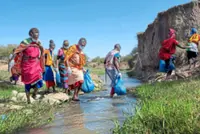Aashu (in red) and Khushi Jangra training at the wrestling academy
AS the winter sun ascends over a mustard farm, pale orange bleeding into sharp yellow, a line of 36 girls all dressed alike – T-shirts, track pants, crew cuts – emerge into an open field, rubbing sleep from their eyes. Under a tin shed, they sit on their haunches, bent over stone mortars.
For the next 20 minutes, they crush raw almonds into a fine paste, straining out a bottle of nut milk. They will need it to regain their strength.
Already a subscriber? Log in
Save 30% OFF The Star Digital Access
Cancel anytime. Ad-free. Unlimited access with perks.





